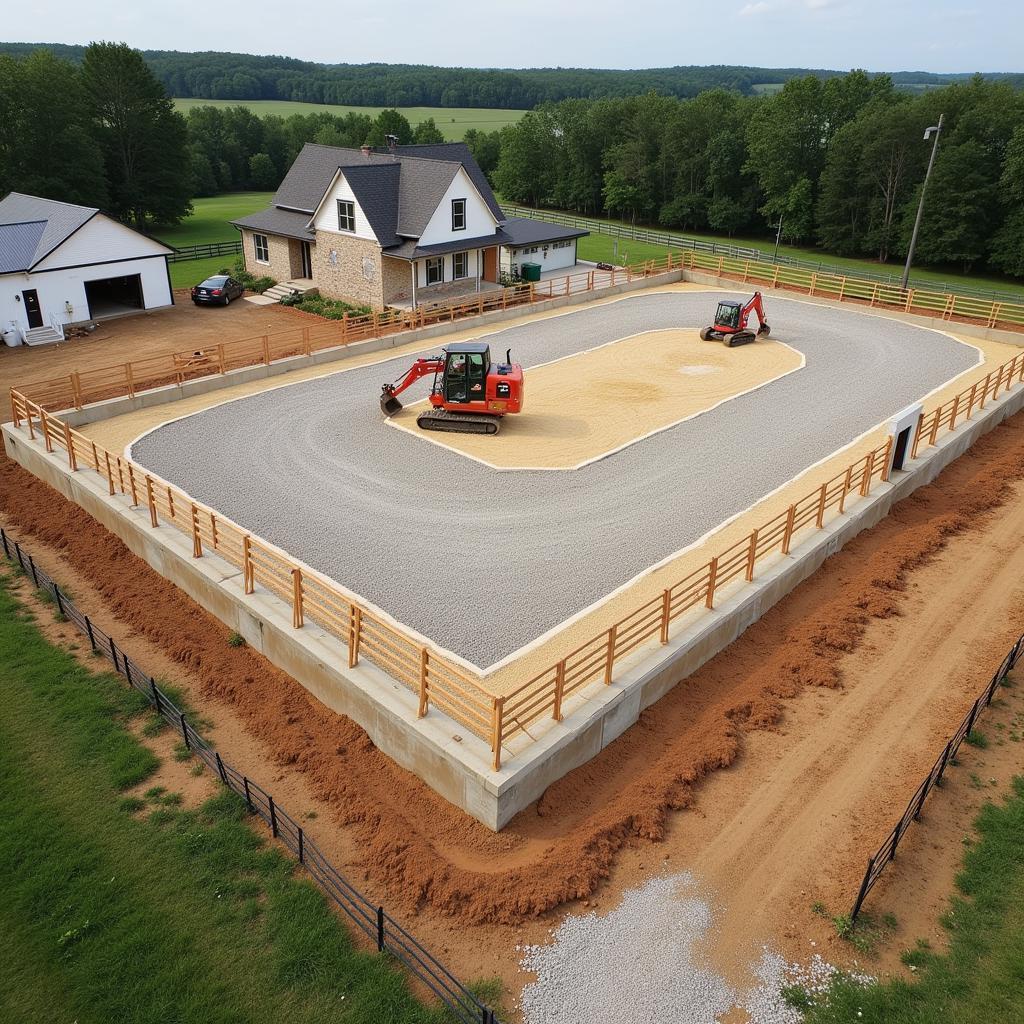A Horse Arena is more than just a space for riding; it’s an investment in your horse’s well-being and your equestrian pursuits. Whether you’re dreaming of a professional-grade facility or a simple paddock for leisurely rides, careful planning and construction are essential. This guide dives deep into everything you need to know about horse arenas, from choosing the right location to selecting the best footing material.
Planning Your Dream Horse Arena: Location, Size, and More
Building a horse arena begins with careful planning. Consider these key factors:
- Location: Choose a well-drained area with easy access to water and electricity. Avoid low-lying spots prone to flooding. A location sheltered from prevailing winds can also make riding more comfortable.
- Size and Shape: The ideal size depends on your riding discipline. A smaller arena is suitable for lunging and basic training, while larger arenas are necessary for dressage or jumping. Rectangular arenas are the most common, offering ample space for various exercises.
- Budget: Horse arena cost can vary significantly based on size, materials, and features. Establishing a clear budget early on helps prevent overspending.
Once you’ve determined the basics, it’s time to focus on the construction process.
Construction Considerations: Base, Footing, and Fencing
The key to a long-lasting and safe horse arena lies in its construction:
- Base: A well-compacted base is crucial for stability and drainage. Several layers of crushed stone and gravel form a solid foundation.
- Footing: Choosing the right sand for horse arena is paramount for your horse’s safety and performance. Different disciplines require different footing characteristics. Consider factors like cushioning, traction, and dust control.
- Fencing: Secure fencing is essential for containing your horse and ensuring safety. Wood, vinyl, and metal are common choices, each with its own advantages and disadvantages.
Proper construction ensures a safe and functional riding environment for years to come.
 Horse Arena Construction Site
Horse Arena Construction Site
Maintaining Your Horse Arena: Dragging, Watering, and More
Maintaining your horse arena is crucial for its longevity and performance.
- Dragging: Regular arena drags for horse arenas help maintain a level and consistent riding surface. It also prevents compaction and improves footing quality.
- Watering: Proper watering is essential for dust control and footing stability. Overwatering can lead to mud, while underwatering can create a hard, unforgiving surface.
- Repairs: Address any damage to the base, footing, or fencing promptly to prevent further deterioration.
Consistent maintenance ensures a safe and enjoyable riding experience.
What are the different types of horse arenas?
There are several types of horse arenas, including indoor, outdoor, and covered horse arena cost. Each offers its own advantages and disadvantages.
How much does it cost to build a horse arena?
The horse arena cost varies depending on several factors, including size, materials, and location.
How do I choose the right footing for my horse arena?
The ideal sand for horse arena depends on your riding discipline and personal preferences. Consulting with an expert can help you choose the best option.
Choosing the Right Horse Arena for You
Building or buying a horse arenas is a significant investment. Careful planning and consideration are essential to ensure you create a safe, functional, and enjoyable space for you and your horse. By focusing on these key elements, you can build a horse arena that will meet your needs and enhance your equestrian experience for years to come.
 Well-Maintained Horse Arena
Well-Maintained Horse Arena
“A well-built horse arena is an investment that pays off in both horse and rider satisfaction,” says renowned equestrian facility designer, Sarah Miller. “By choosing the right materials and prioritizing regular maintenance, you can ensure a safe and enjoyable riding experience for years to come.”
“Don’t underestimate the importance of proper footing,” adds veteran horse trainer, John Davis. “The right footing can significantly impact your horse’s performance and prevent injuries.”
In conclusion, building a horse arena is a significant undertaking, but with careful planning and execution, it can be a rewarding investment. By considering factors like location, size, construction materials, and maintenance, you can create a safe and enjoyable space for you and your horse. Remember, a well-built horse arena is more than just a place to ride; it’s an investment in your equestrian future.
FAQ
- What is the best type of fencing for a horse arena?
- How often should I drag my horse arena?
- What is the ideal depth of footing for a horse arena?
- How can I prevent my horse arena from flooding?
- What are the different types of arena drags available?
- How do I choose the right lighting for an indoor horse arena?
- What are the best practices for maintaining a horse arena during different seasons?
Need help with your horse arena project? Contact us! Phone: 0772127271, Email: [email protected] Or visit us at: QGM2+WX2, Vị Trung, Vị Thuỷ, Hậu Giang, Việt Nam. We have a 24/7 customer support team.